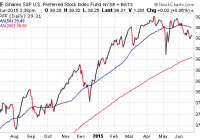Why Income Investors Should Not Ignore Preferred Stock ETFs
Preferred stocks have been quite popular among income-seeking investors due to their juicy yields but many now wonder how these securities will perform in a rising rate scenario. We believe that there is still a case for investing in these securities. What are Preferred Stocks? Preferred stocks are hybrid securities that have characteristics of both debt and equity. They have a higher claim on assets and earnings than common stock. Preferred stocks are either perpetual (without any maturity date) or have long-term maturity (30 to 50 years). Like bonds, preferred stocks are usually rated by rating agencies. Most preferred dividends have the same tax advantage that the common stock dividends currently have. However, while companies have the obligation to pay interest on the bonds that they issue, dividends on preferred stock can be suspended or deferred by the vote of the board. Why Should You Invest in Preferred Stocks? Juicy yields around 5-6% are the main attraction for investors. Further, preferred stocks have low correlations with common stocks and hence add diversification to a stock-centric portfolio. Further, these securities have much lower volatility than stocks and provide stability to portfolios. Risks Like bonds, preferred securities are sensitive to changes in the interest rates. In the event of rising interest rate, the value of these securities will fall. But I believe that in the current scenario, when interest rates are expected to stay “lower for longer,” the impact will be minimal. Preferred securities also face credit risk as the issuer may not be able to meet the claims of investors. However, both the ETFs that we have discussed below have minimal exposure to energy sector, where chances of default are higher. Many preferred securities have call provision, i.e. the issuer has the right to redeem its preferred stock or convert it to common stock, but call is usually exercised by issuers when interest rates are falling. ETFs to Consider iShares S&P U.S. Preferred Stock Index (NYSEARCA: PFF ) is the most popular and liquid preferred stock ETF in the space. It has a lot of exposure to banks and other financials, which are expected to do well in rising rate scenario. PowerShares Variable Rate Preferred Portfolio Fund (NYSEARCA: VRP ) holds variable- and floating-rate preferred stocks which reduces interest rate risk. Thus, VRP could be a nice option for income-seeking investors in the rising rate scenario. To learn more, please watch the short video below: Original Post
